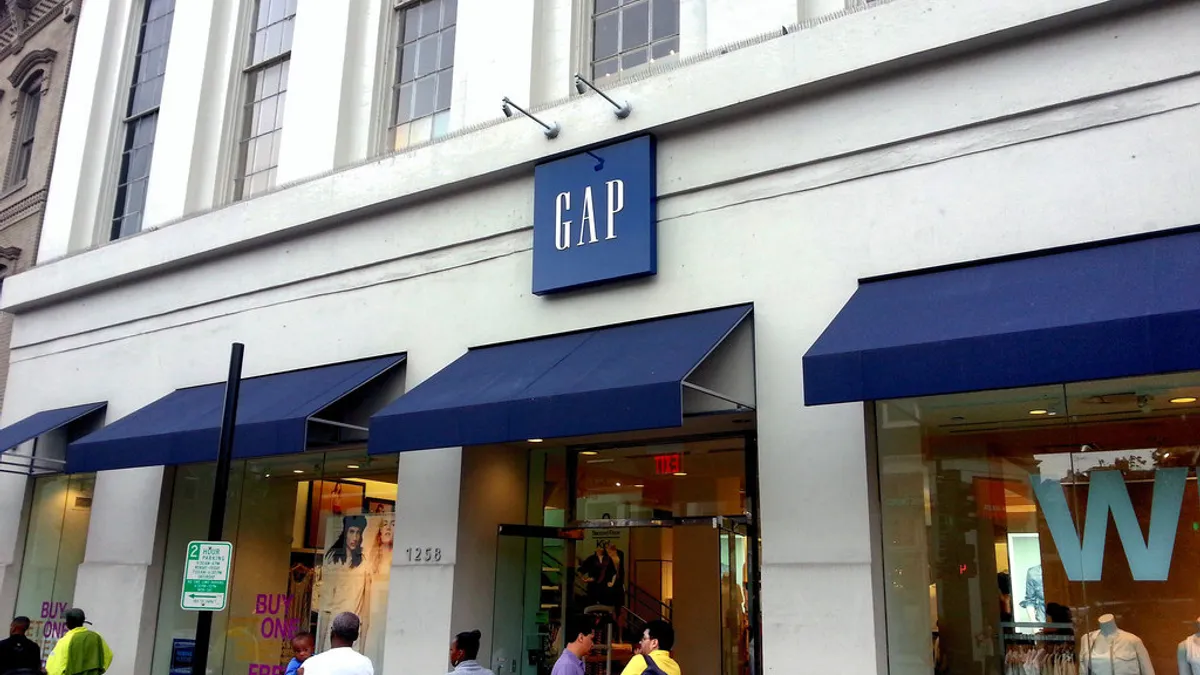Dive Brief:
-
Speaking at a Tuesday shareholders meeting, Gap Inc. CEO Art Peck said that the struggling apparel retailer should rely on third-party sellers to expand its customer reach and that it would be “delusional” not to consider selling on Amazon, according to Bloomberg.
-
Peck's efforts to rejuvenate the Gap and Banana Republic brands continue to fail to gain traction, and even the Old Navy brand, once a bright spot, has stumbled in recent quarters.
-
On Twitter, Forrester Research retail analyst Sucharita Mulpuru said that it would be “idiotic” for Gap to sell on Amazon, and that Wal-Mart, Target and Costco would all be better choices.
Dive Insight:
For Gap, an apparel retailer that once pretty much defined American casual wear but now seems to have little definition at all, it does seem that it's time to think creatively about how to reach consumers.
But while Forrester’s Mulpuru does seem to think that Gap could expand its sales channels beyond its own stores and website, she clearly doesn’t believe that Amazon is the answer.
The most idiotic thing Gap could do is sell its products on Amazon. WMT, TGT, COST would all be better accounts: https://t.co/aN5xqqqgho
— Sucharita Mulpuru (@smulpuru) May 18, 2016
When asked by Retail Dive to expand on her tweet, Mulpuru said that, considering Amazon's reputation for mining data from suppliers so it can ultimately offer similar products for cheaper and/or better, "Gap selling on Amazon is letting the fox in the hen house."
"There's no good that will come of it," she told Retail Dive in an email. "Target and Costco have less of a reputation for cannibalizing suppliers."
"Target in particular is famous for pushing apparel inventory when it's marketed as a prestigious diffusion line," she also said. "Physical stores are challenged.They are looking for new ways to freshen their assortments and create something new that's compelling to shoppers. That could be Gap-branded stores within stores. It would move a lot of the units and provide some new energy to otherwise tired apparel departments in multicategory stores."
Peck didn’t necessarily mean that Gap is in any way at all deep into any consideration of Amazon as a seller of its apparel, of course. His remarks were in answer to a question at a shareholders meeting, according to Bloomberg. But the fact that Amazon has long sold apparel from several brands and has recently launched its own stable of private-label apparel and accessories may force Peck to give the matter serious thought.
The trouble is, many brands have suffered on Amazon thanks to competition from third-party sellers that undermine prices and sometimes even their customer service standards.
The fact that Amazon is now selling its own lines of apparel may actually make it a worse partner for Gap. Amazon can be a brutal competitor: Last year it banned sales of sales of Apple TV and Google’s Chromecast and Nexus Player from its site, and also infamously played hardball with a series of book publishers when contracts came up for renewal.
In fact, Gap may be better off considering its own marketplace and avoiding the trap that selling on Amazon can be for brands, says Adrien Nussenbaum, marketplace platform startup Mirakl's U.S. CEO and co-founder, who agrees with Mulpuru that Amazon could end up using Gap's data for its own sake.
"Although in the short term Gap could increase sales via Amazon, it would be a strategic mistake: Amazon would use the sales data to improve their own apparel inventory and undercut Gap, while Gap would dilute its brand and lose its direct relationship with the customer," Nussenbaum told Retail Dive. "Gap should consider adding a marketplace to its website, and sell products from brands aligned with its target: it would turn gap.com into a destination website, increase revenue, and optimize inventory and traffic in-stores. What's more, Gap.com already links to Banana Republic and Athleta, its sister brands. Gap could invite smaller, complementary brands to sell on its marketplace, and turn its website into a destination for all things casual wear.”
Gap Inc. reported earlier this month that Q1 same-store sales fell 5%, compared to a 4% decrease in the year-ago quarter. By brand, Gap Q1 same-store sales fell 3% (compared to a 10% dip a year ago); Banana Republic plummeted 11% (compared to 8% last year); and Old Navy dropped 6% (compared to a 3% increase last year).













